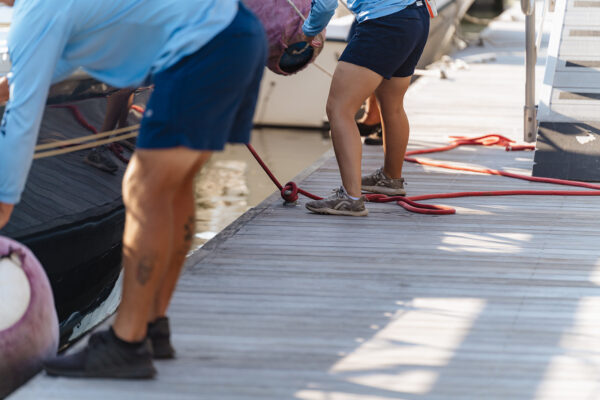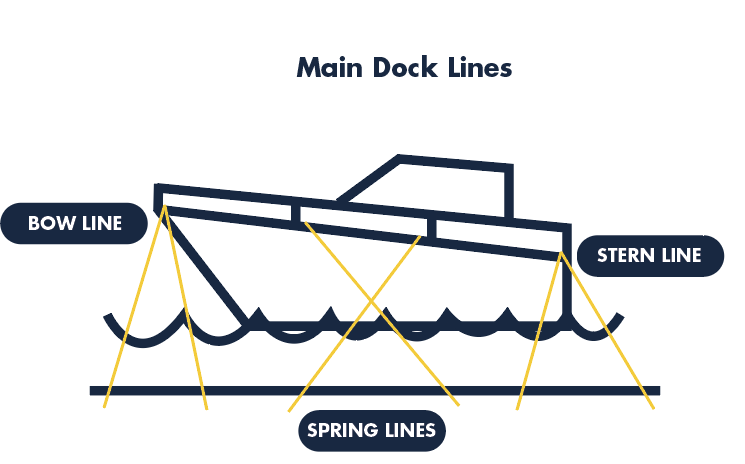Properly Securing Your Vessel to the Dock
Anyone who has ever spent any amount of time out on the water knows just how important it is to always observe safe boating practices, even when it comes to heading back to the marina or dock at the end of the day. In fact, depending on the weather conditions, ensuring that your vessel has been properly secured to the dock is one of the most important things you can do to protect your boat even when you’re not around!
Just because you’re done for the day doesn’t mean your work is done until your boat has been properly secured to the dock or slip. Let’s talk about all of the important steps you need to follow in order to safely secure your vessel after pulling it up to the dock like a boss.

Identifying Important Parts of Your Boat
No matter what the circumstances, it is so important to really know your boat from top to bottom, and be able to properly identify all of the different parts that are involved in the docking process. Although all boats vary to some degree, here are a few essential areas to familiarize yourself with:
The Bow: the bow refers to the front of the boat. The left side of the boat is referred to as the port side, and the right side of the boat is considered starboard.
The Stern: the stern refers to the rear of the boat.
The Lines: the lines are the ropes that come off of the boat in order to be secured to the dock or slip. There are three important lines to know when it comes to docking:
- Bow Line: the line that comes off the port or starboard side of the bow cleat.
- Spring Line: the line that comes off the port or starboard side of a boat cleat and is positioned between the bow and stern.
- Stern Line: the line that comes off the port or starboard side of the stern cleat.

Boat Cleats: the cleats are the metal fittings that are secured around the boat on which a rope can be properly fastened.
Fenders or Bumpers: these are the cushions that prevent a boat from being damaged due to rubbing or impacting the dock or being in contact with other boats. There are both inflatable or non-inflatable fenders or bumpers that are typically used when securing a boat.
How to Tie a Boat to a Dock or Slip
The preparation process for docking begins well before you reach the dock. First, run through a quick mental checklist of all the gear you will need at the ready in order to secure your boat. This will include your lines, fenders or bumpers. You will also want to slow down and consider the angle you approach the dock or slip, including which direction the wind and currents are pulling you.
Morningstar Marinas Pro Tip → In case you missed it, here’s a quick guide to learning to dock like a boss.
Get your dock lines ready by preemptively tying them to your boat’s cleats. Keep your lines organized and untangled, and throw your fender over the side before you dock so they can absorb the brunt of any impact.
Determine what type of tie-off you’re going to need to do with your lines: bow line, spring line, stern line, or docking into a slip where there is dock on both sides to secure your vessel. Avoid dropping your lines into the water, because they could get caught up in your or another boat’s prop.
Tying Off at the Dock
In order to make sure the tension load is evenly distributed across the lines, you’ll need to carefully follow these steps in order:
- Start by tossing your spring line to someone who is waiting on the dock so they can adjust the position of the boat and hold it in place.
- First, tie the bow line to the dock cleat that is ahead of the bow.
- Next, tie the spring line at an away-angle from the bow, towards the stern, tying it off at the spot closest to the stern. This is crucial to keeping the boat from moving backwards and forwards.
- Lastly, tie the stern line behind the stern, preferably at an equal distance from the midship as the bow line has been tied.
Tying Off at the Slip
- Start by tossing your spring line to someone who is waiting on the dock so they can adjust the position of the boat and hold it in place.
- Tying up in a slip typically works best with four dock lines — two bow lines and two stern lines.
- Run your bow lines forward and cross your stern lines, this way all lines are working together to limit motion all around.
- If you expect a lot of wind or a strong current, add another set of spring lines for extra security.
Safety First: Important Reminders
Remember: every boat and scenario is going to be different, so it’s important to understand that not all docking situations will be the same every time! Because of this, you always need to be aware of your current boating conditions as well as the docking and weather conditions you’re encountering at the time.
Regardless of the situation, always wear your personal flotation device (PFD) while the boat is being tied, as well as when you are exiting the vessel. Take your time with tying off the lines, and make sure to double-check that everything has been done properly before leaving your boat.
Morningstar Marinas is Here to Help
At Morningstar Marinas, we pride ourselves on the community of boaters we’ve created across the Southeast’s top boating destinations. Our facilities and services paired with our friendly and knowledgeable team members will help you quickly and efficiently get out there on the water, so you can start having fun! Morningstar Marinas is more than just a place to store your boat — we’re your home away from home.
